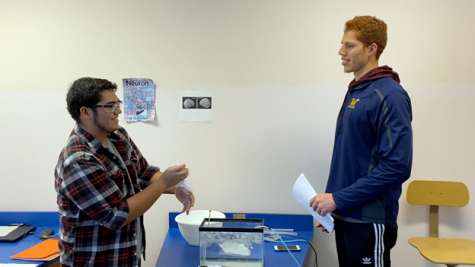Research team looks at how emotions affect pain perception
Dr. Edward Schicatano studies the on the neurological mechanism behind acute pain.
A Wilkes University research team led by Dr. Edward Schicatano, professor of psychology, is seeking to understand how emotions affect our perception of physical pain.
Previous studies have demonstrated significant links between psychological pain and physical pain but the vast majority of this research has thus far focused on chronic pain. Schicatano is focusing on the neurological mechanisms behind acute pain, pain that only lasts a maximum of six months and is typically caused by soft tissue damage.
Acute pain can be simulated with a cold pressor test, where one’s pain perception in response to contact with ice water is tested.
Schicatano’s team looks at three variables: pain detection, pain tolerance and pain perception. Schicatano chose these three measurements because he believes they are all regulated by separate, independent neurological mechanisms.
This is a part of a series of studies into pain perception that Schicatano has been running since 2011. While information on the studies’ results is limited so far, several participants will be run through the tests this coming week.
One of the students helping to run this study is Abdul Almecky, a senior pre-med student here at Wilkes. He says he chose Schicatano’s research to be his senior capstone because of it’s growing relevance to the medical field.

Student researchers Chris Perez and Abdul Almeky in the research lab.
“This will help me in my practice of medicine because the idea of pain perception is a hot topic in today’s society and the answers on how to alleviate pain in many medical conditions are still unknown,” Almecky said.
Schicatano’s research deals with a psychosomatic topic, so there are sometimes issues in ensuring the objectivity of the results because the subjects report measurements on Schicatano’s three variables themselves through surveys.
According to Almecky, it is often difficult to account for students “exposure to similar projects.” If a subject has taken part in similar studies and thinks they know what a researcher is “looking for” from this research, this may alter what they perceive or what they report in their surveys, even if only subconsciously.
The only real way to counter this problem is to screen research subjects and try to uncover any potential bias beforehand.
While these factors sometimes make it difficult to form a definite conclusion, both Schicatano and the students under him have reported steady progress with regards to this study. In addition, these students hope to gain valuable knowledge that will help them in their future careers.
“As an aspiring physical therapist, I would like to know how people can try to control their emotions more efficiently in order to have less pain while undergoing therapy,” said psychology major Francesca Valera-Seri, discussing potential applications of this research. “If patients can manage their emotions well, then it will become easier for them to recover faster from their injuries.”
After this, they plan to gather all of the data collected and compare it to Schicatano’s hypothesis.
“Research will continue for a long time.“ Schicatano said. “There are just too many research questions left to stop now.”